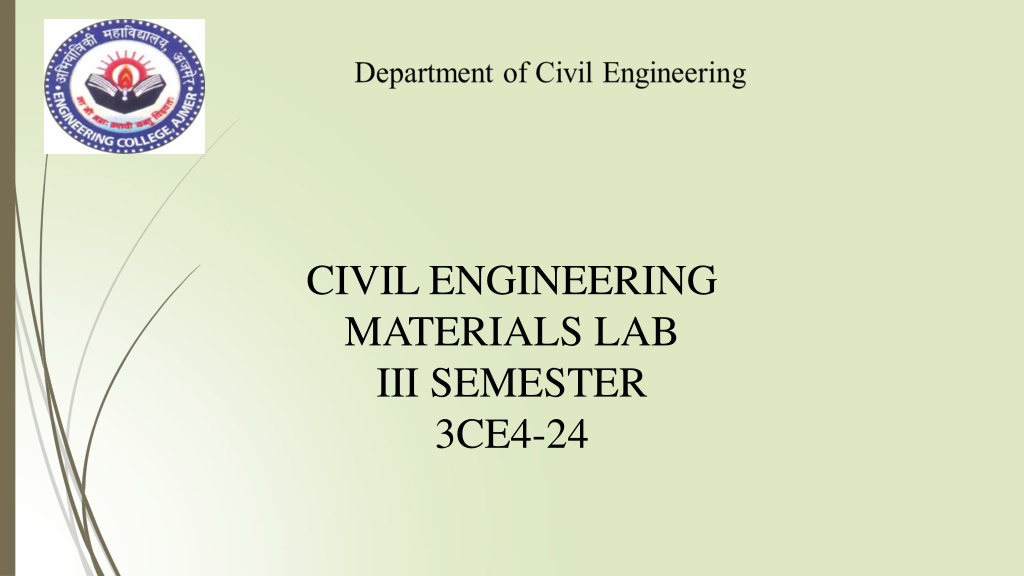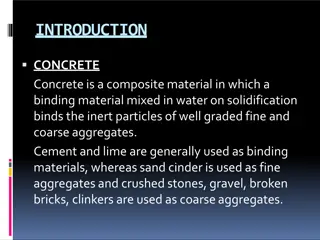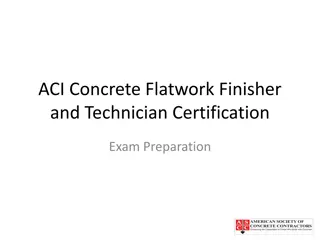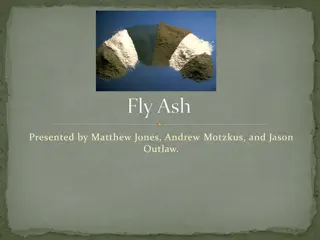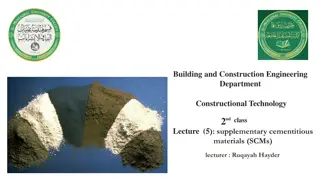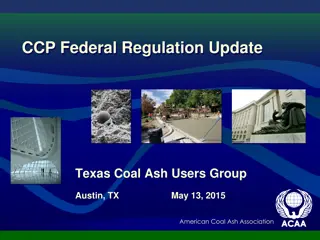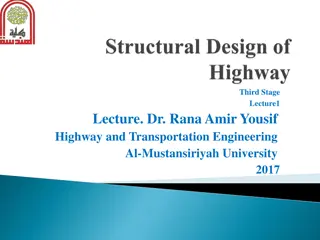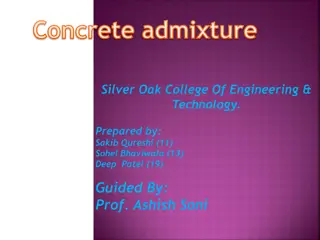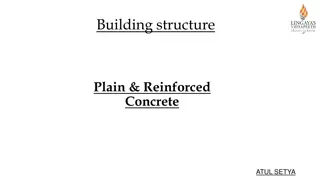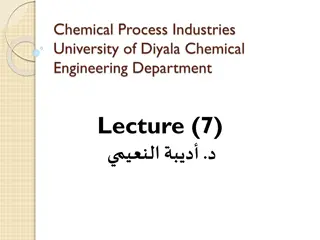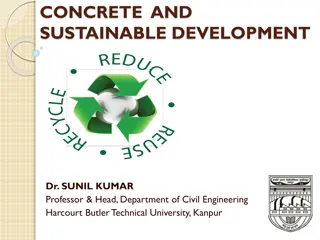Exploring High Volume Fly Ash Concrete in Civil Engineering
High Volume Fly Ash Concrete is an eco-friendly alternative in construction, where fly ash partially replaces Portland cement. This material offers several benefits but is limited to specific replacement percentages. Understanding the properties, compositions, and benefits of using fly ash concrete can lead to more sustainable construction practices.
- Fly Ash Concrete
- Civil Engineering
- Sustainable Construction
- Eco-friendly Material
- High Volume Concrete
Download Presentation

Please find below an Image/Link to download the presentation.
The content on the website is provided AS IS for your information and personal use only. It may not be sold, licensed, or shared on other websites without obtaining consent from the author. Download presentation by click this link. If you encounter any issues during the download, it is possible that the publisher has removed the file from their server.
E N D
Presentation Transcript
CIVIL ENGINEERING MATERIALS LAB III SEMESTER 3CE4-24
PROPERTIES OF HIGH VOLUME FLY ASH CONCRETE 1
OVERVIEW 2 INTRODUCTION PROPERTIES OF FRESH HVFA CONCRETE PROPERTIES OF HARDENED HVFA CONCRETE CONCLUSION
INTRODUCTION 3 Fly ash concrete is an eco-friendly construction material in which fly ash replaces a part of Portland cement. But IS:456 2000 and ACI:318 allows replacement of OPCby Fly ash up to 35% only as binding material. High volume fly ash concrete is a concrete where a replacement of about 35% or more of cement is made with the usage of fly ash.
WHAT IS FLY ASH? Fly ash is a finely divided byproduct resulting from the combustion of coal in power plants. It contains large amounts of silica, alumina and small amount of unburned carbon, which pollutes environment. It is grey in colour and alkaline in nature. The particle size ranges between 1-100 microns. The specific gravity of FA lies between 1.9 and 2.8 (generally 3.15 for Cement) 4
5 The surface area is typically 300 500 m2/kg, although some FA can have a surface area as high as 700 m2/kg ( around 330 m2/kg for Cement ) The mass per unit volume including air between particles ( density ) can vary from 540 to 860 kg/m3.
Classification of Fly Ash 6 Two classes of fly ash are defined by ASTM C618: Class F fly ash Class C fly ash This classification is based on the chemical composition of FA i.e. the sum of silica, alumina and iron oxide percentages in the FA, being : minimum of 70% for a Class F minimum 50% for a Class C
7 SOURCE: www.caer.uky.edu/kyasheducation/flyash.sht ml SOURCE: www.gradjevinarstvo.rs
ISSUES WITH OPC 8 Conventional Portland Cement is the most consumed commodity in the world after water. It is also the most energy intensive material Cement production leads to high carbon-dioxide emission. CO2 is the primary green house gas that causes global warming manufacturing of cement accounts for 6 to 7% of the CO2 that humans produce. It is produced by calcination of limestone and burning of fossil fuels
WHY TO USE FLY ASH? 9 being a pozzolanic, it can actually replace a part of Portland cement results in more durable concrete high ultimate strength improves workability improves cost economy of concrete reduction in heat of hydration decreases density of concrete more environment friendly concrete.
EFFECT OF HIGH VOLUME OF FLY ASH ON PROPERTIES OF FRESH CONCRETE 10 1. WORKABILITY 2. SETTING TIME, BLEEDING AND SEGREGATION 3. HEAT OF HYDRATION 4. DENSITY
WORKABILITY 11 The inclusion of high volume of fly ash increases the workability as the content of FA is increased. The increment in the slump height is about 40% and 54% with the inclusion of 45% and 50% FA, respectively. generally higher substitution of Portland cement by fly ash reduces the water requirement for obtaining a given workability
12 . Effect of fly ash fineness & % on water demand of concrete
WORKABILITY 13 reduction in water requirement is mainly due to three mechanisms: Fly ash gets absorbed on the surface of oppositely charged cement particles and prevent them from flocculation, releasing large amounts of water, thereby reducing the water-demand for a given workability. The spherical shape and the smooth surface of fly ash particles help to reduce the interparticle friction and thus facilitate mobility Due to its lower density and higher volume per unit mass, fly ash is a more efficient void-filler than Portland cement.
Contributions of enhanced workability: 14 Light weight concrete is easier to pump as pumping requires less energy. Improved finishing Reduced segregation and bug holes Reduced Bleeding Less sand is needed in the mix to produce required workability. Back
SETTING TIME 15 High volume of fly ash extends both the initial and final setting time of concrete The impact of fly ash on the setting behavior of concrete is dependent on: composition and quantity of fly ash used amount of cement water - to cementitious material ratio concrete temperature
16 Effect of FA content on penetration resistance of setting concrete mixture
Bleeding and Segregation 17 The inclusion of high volume of fly ash in the mixture reduces the bleeding and segregation. Reason: the rate and amount of bleeding decreases due to the reduced water demand. The reduction of bleeding and segregation may be related to the lubricating effect of the glassy spherical FA particles. Back
HEAT OF HYDRATION 18 Both the maximum rate of heat evolution and the cumulative heat evolution decrease with the inclusion of 45% FA during the first 72 hours. The inclusion of 45% FA results in 36% reduction in the cumulative heat evolution. In addition, the time of reaching the maximum rate of heat evolution delays.
Effect of fly ash on heat of hydration 19 Source: optimizing-the-use-of-fly-ash-in-concrete by Michael Thomas (www.cement.org)
Effect of fly ash on temperature rise 20 Source: optimizing-the-use-of-fly-ash-in-concrete by Michael Thomas (www.cement.org) Back
DENSITY 21 Inclusion of high volume of fly ash in the mixture decreases its density which leads to a reduction in the dead weight of the constructed element. Reason: This reduction in the density could be attributed to the lower specific gravity of FA (1.9 to 2.8) as compared to cement (3.15) Back
EFFECT OF HIGH VOLUME OF FLY ASH ON PROPERTIES OF HARDENED CONCRETE 22 1. COMPRESSIVE STRENGH 2. DURABILITY
COMPRESSIVE STRENGH 23 TEST 5 mixtures were considered , 3 of them with OPC and varying FA content, and 2 control pastes using 100% OPC or 100% BC. conducted using 40%, 60% and 80% FA replacement by volume of cement maintaining the w/b by mass constant at 0.42
MIXTURE PROPORTIONS OF THE PASTES 24 Cement Fly ash Fly ash Water Mixture ID (kg/m3) (%) (kg/m3) (kg/m3) 1359.7 0 0.0 571.1 OPC 1307.5 0 0.0 549.1 BC 864.4 40 434.5 545.5 40-F 594.0 60 671.7 531.6 60-F 306.4 80 924.0 516.7 80-F SOURCE: Felipe Rivera, Patricia Mart nez, Javier Castro, Mauricio L pez Massive volume fly ash concrete , Cement and Concrete Composites, Volume 63, October 2015
The cement pastes were prepared in a mechanical mixer 25 50-mm cube specimens were cast (3 specimens per age) At the age of 24 h, the specimens were demolded and placed in vacuum sealed plastic bags in a moist room, (95 3)% RH and (23 2) C, until the age of testing.
The compressive strength gain after 3 d, 7 d, 28 d and 90 d for each mixture 26 SOURCE: Felipe Rivera, Patricia Mart nez, Javier Castro, Mauricio L pez Massive volume fly ash concrete , Cement and Concrete Composites, Volume 63, October 2015
27 The compressive strength of the 40-F paste is similar to that of the OPC paste at any age while that of the 60-F paste is very similar to the BC paste at early ages (3 d and 7 d) and higher at 28 d and 90 d. The compressive strength of the 80-F paste is lower than that of the BC paste at any age; its strength can reach up to 22 MPa at 28 d and 35 MPa at 90 d.
28 Source: optimizing-the-use-of-fly-ash-in-concrete by Michael Thomas (www.cement.org)
Rate of strength gain 29 The rate of strength gain in the FA-F pastes increases with the replacement level. Between 28 d and 90 d, the strength gain of OPC paste is similar to that of the BC paste but lower than that of the 80-F paste ( 0.21 MPa/d). For the 40-F and 60-F pastes, the strength gains are the lowest ( 0.07 MPa/d and 0.08 MPa/d, respectively), between 28 d and 90 d. Back
DURABILITY 30 Abrasion Resistance The mix containing 70% FA exhibits a slightly lower abrasion value than the concrete containing 50% FA and OPC concrete although 70% FA exhibits a higher abrasion value below a certain compressive strength. The abrasion resistance is mainly dependent on the compressive strength of concrete. It is assumed that C-S-H of 50% FA or OPC provide better cohesion to the aggregate-sand-paste and therefore better resist the action of surface shear forces.
31 Permeability and Resistance to Penetration of Chlorides Fly ash reduces permeability of concrete to water and gas provided the concrete is adequately cured, due to a refinement in the pore structure. Through pozzolanic activity, fly ash chemically combines with water and CaOH2 forming additional cementitious compounds, therefore : it is not subject to leaching it decreases bleed channels, capillary channels and void spaces and thereby reduces permeability.
32 With the use of fly ash, concrete becomes nearly impermeable to cs ihglnoirf iicdaenst layn. d the rate of chloride penetration decreases Source: optimizing-the-use-of-fly-ash-in-concrete by Michael Thomas (www.cement.org)
Alkali- Silica Reaction Class F fly ash is capable of controlling alkali silica reaction in concrete even at moderate levels of replacement (20% to 30%) Reason : concentration of alkali hydroxides is reduced in the pore solution when fly ash is present The level of fly ash required to suppress expansion of concrete increases with: Increased calcium and alkali content of fly ash; Decreased silica content of fly ash; Increased aggregate reactivity; Increased alkali availability from Portland cement and environment 33
There is low risk of concrete expansion occurring in the field when very high volume fly ash concrete with 50% or more fly ash is used. 34 Source: optimizing-the-use-of-fly-ash-in-concrete by Michael Thomas (www.cement.org)
Sulfate Resistance HVFA concrete specimens exhibit higher sulfate resistance. The specimens containing 60% FA as 35 cement replacement exhibited better performance in lactic/acetic and sulfuric acid FA induces three phenomena which improves sulfate resistance: consumes the free lime resulting it unavailable to react with sulfate, reduces permeability which prevents sulfate penetration, and by replacing cement, the reactive aluminates are reduced. reduced.
Carbonation and Corrosion Resistance When concrete specimens are exposed to different methods of carbonation, the results show a reduction in the carbonation resistance of concrete specimens with the inclusion of 50% FA as cement replacement. Therefore there is increase in the carbonation depth of concrete specimens in areas prone to carbonation, particular attention must be paid to ensure suitable: concrete mix proportions, period of moist curing, and depth of cover 36
37 Source: optimizing-the-use-of-fly-ash-in-concrete by Michael Thomas (www.cement.org)
Resistance to Cyclic Freezing and Thawing, and Deicer Salt Scaling Concrete can be resistant to cyclic freezing and thawing provided: 38 it has sufficient strength an adequate air void system the aggregates are frost resistant. This holds true for fly ash concrete concrete containing fly ash is less resistant to scaling when subjected to freezing and thawing in presence of deicer salts. For fly ash concrete structures exposed to de-icing salts the following observations have been made: scaling increases as the w/cm increases scaling mass loss increases with fly ash content the use of curing compounds reduces scaling Back
CONCLUSION Use of high volume fly ash concrete in construction is one big step in natural resource conservation and it needs to be promoted all over the world. In fact, we can call high volume fly ash concrete as a green concrete, since it can protect the environment from global warming and at the same time from pollution. There may be some negativity attached to it like slower construction rates as it gains strength slowly and gives lower early strengths. But, the same can be ignored as the later strengths (90 days or more) and durability of high volume fly ash concrete is much better than plain concrete. 39
Clearly there is no one replacement level best suited for all applications. The inclusion of high volume fly ash in the mixture causes : Reduced the heat of hydration, bleeding, segregation, density, but increased workability and setting time. Decreased the mechanical strength especially at early ages with increasing FA content. Increased durability of concrete reduced resistance against Deicer Salt Scaling. 40
Product Comparisons Conventional Concrete Energy intensive manufacturing Weaker ultimate strength Less durable Uses virgin material More global warming gases created High Volume Fly Ash Concrete Less energy intensive manufacture Higher ultimate strength More durable Uses a waste by-product Less global warming gases created
